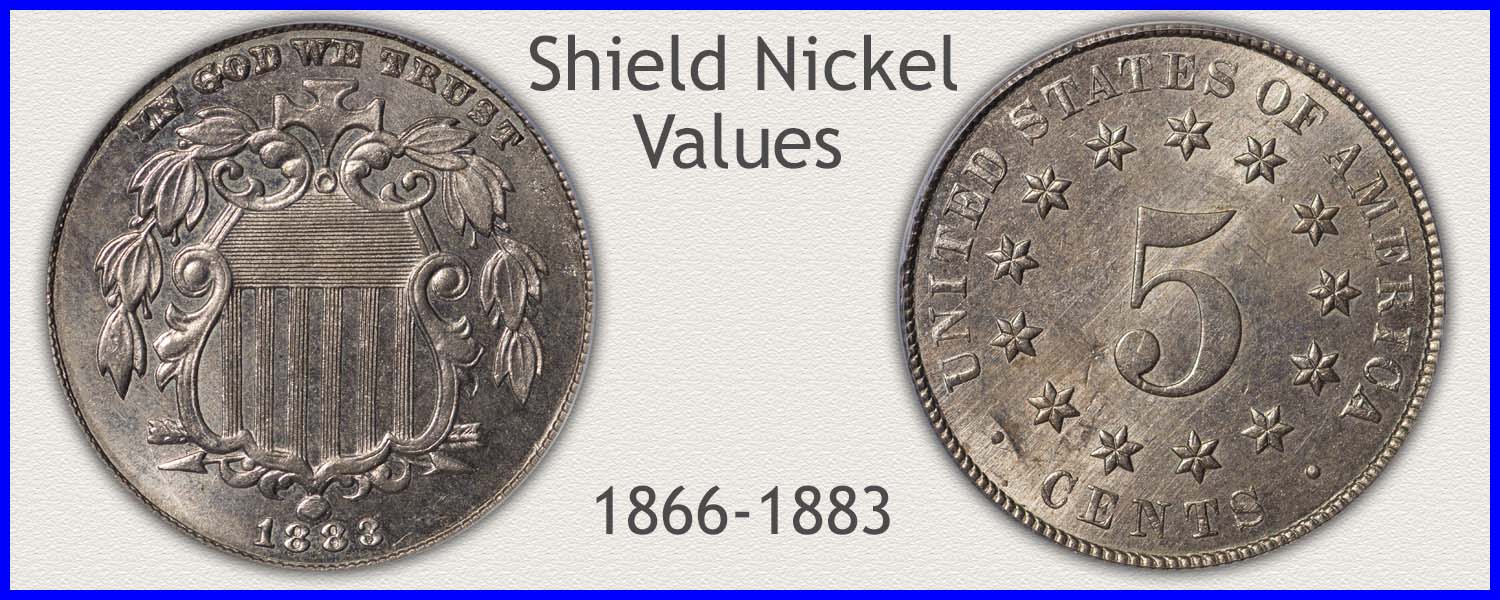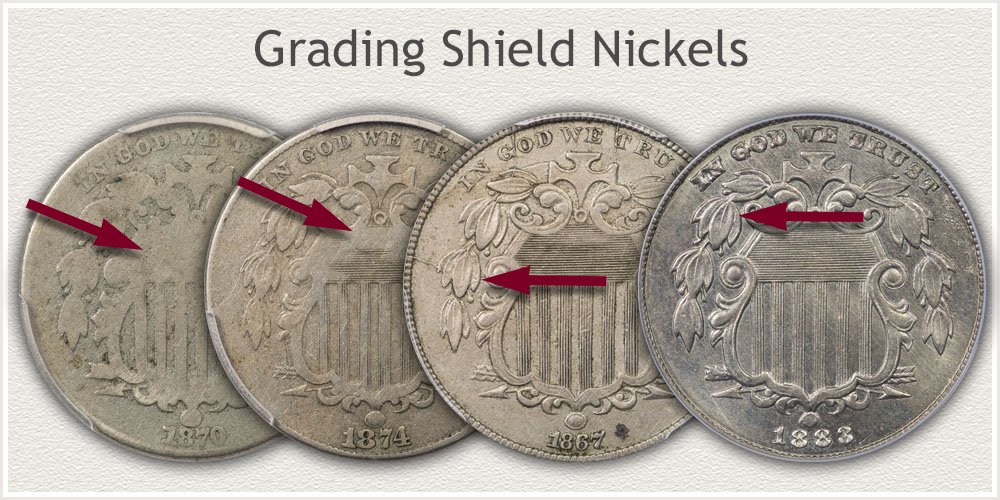Coin Values Moving with Precious Metals: Up-Dated 12/15/2025: Gold $4341 | Silver $63.26
1871 Nickel Value
A very low production year, 1871 nickel value reflects the rarity of these coins. Those few remaining are typically in very worn condition. This remains a popular year within the Shield Nickel series. A coin with eye appeal, notable detail, and surfaces showing careful handling is in strong demand. Collectors seek these qualities. Importantly, the market awards high premiums to a better than average coin.
Follow the step-by-step procedure outlined. Exceptional qualities are highlighted with images providing close-up references. Starting with a review of the value chart, it shows the potential of how much an 1871 nickel is worth.
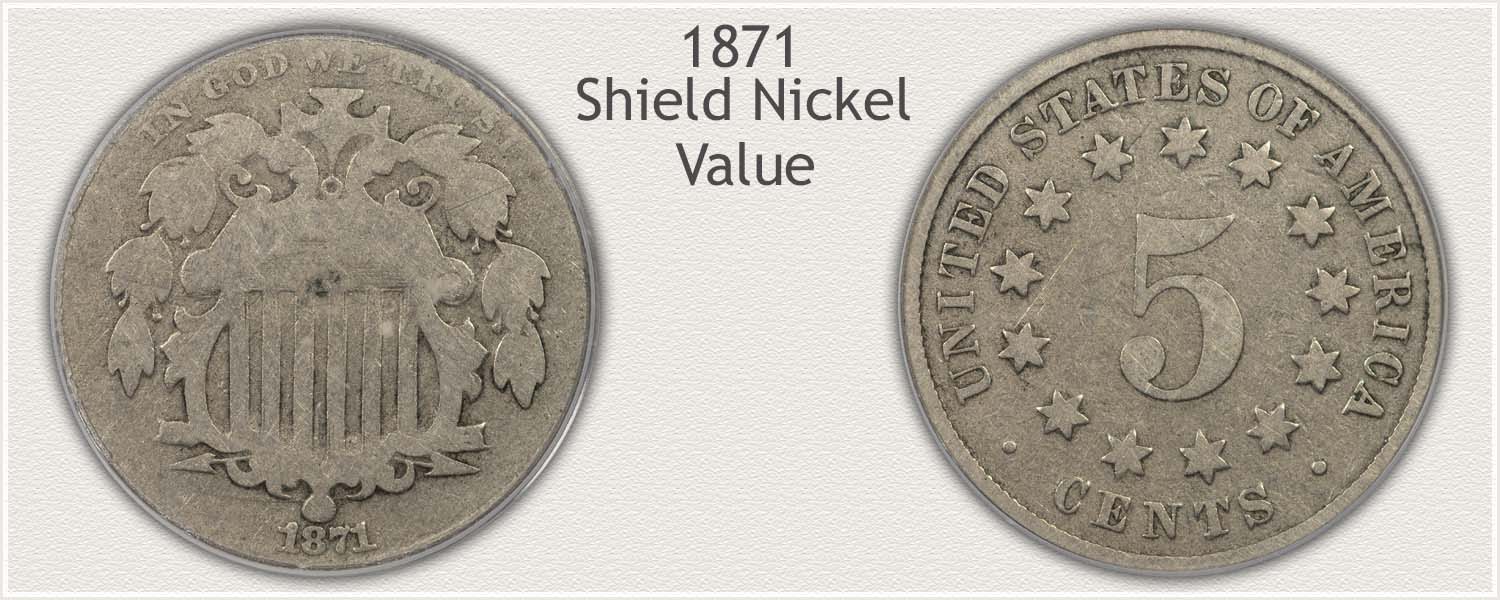
Steps Leading to Value:
- Step 1: Date Identified - Understanding a nickel's place in the coin hobby starts with its date. A key factor determining its demand. Verify with a second look, then record the date of this important coin in the Shield nickel series.
- Step 2: Grading Condition - Noted are large increases in value as you recognize higher condition. Judging condition narrows this range.
- Step 3: Special Qualities - Historical records provide many of the reasons 1871 is a special year nickel.
| 1871 Nickel Value | ||||
|---|---|---|---|---|
| Condition of Coin | ||||
| Date | Good | Fine | Extremely Fine |
Mint State |
| 1871 Nickel Value Updated | 2025 | |||
| 1871 | $47 | $90 | $169 | $337 |
The above chart lists a range of wholesale values these nickels trade within the market. Note, because of scarcity, small improvements in preservation have a large impact on premiums.
Step 1: 1871 a "Key" Date to Confirm
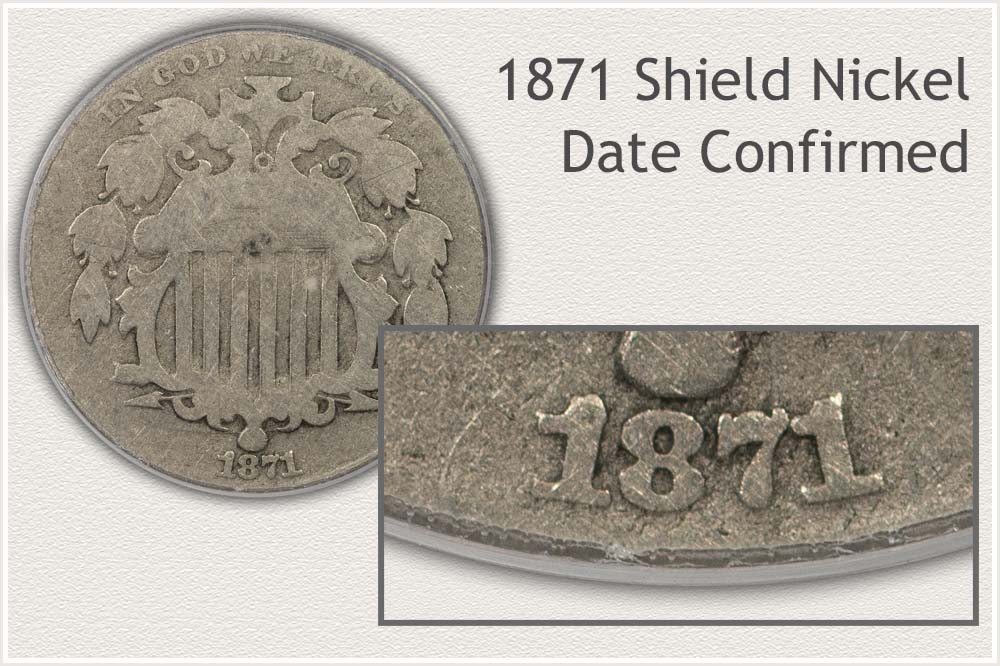
Production of 1871 nickels began slowly, stayed slow, and ended at very low levels. At the end of the year, the Philadelphia mint reported minting 561,000. This mintage, in context with all nickels, is significant as under one million. Drawing attention from collectors, there is a steady demand for the coin today.
Values of moderately worn 1871 nickels are affordable to many collectors. An example in upper condition also appeals to advanced collectors and considered affordable. This is a scarce and popular coin. Nice examples entering the market quickly find a place in a collection of Shield nickels.
It is important to accurately record the date. Rendered very small on the coin, examine under the shield along the rim. Known as a "key" date of the Shield series, inspect closely to confirm. Condition of the piece is the next deciding factor in its value.
Step 2: | Inspect the Coin and Compare to Images Helping Grade Shield Nickels
Identifying Small Details Finds Premium 1871 Nickels
Collectors consider 1871 nickels as scarce in high condition. Examining its condition and determining a grade is the next important step. Grades are terms used in the coin market to define a coin's condition. Each grade has certain standard requirements. Details of the design, surface preservation, and the amount of wear are all part of an evaluation. Separate coins by their condition using grading images and finding a close match.
Next, focus on the areas described in the descriptions of the grade. The shield design provides many details used to gauge wear amounts. Verifying that defined levels of detail remain visible confirms the grade.
Mint State Grade
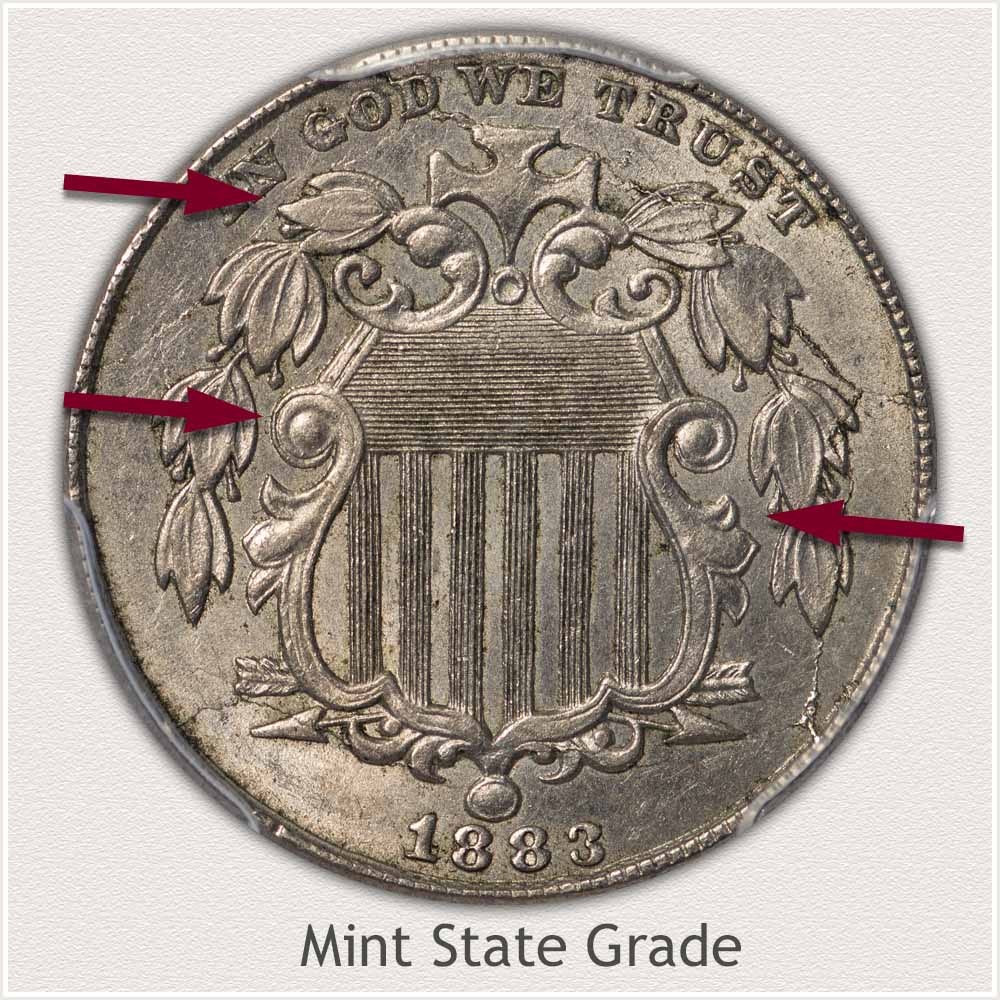
Mint State: Mint State coins are highly prized by collectors because of their pristine condition. In particular, 1871 Shield nickels are elusive in top quality condition. This is a coin preserved in the same condition as when it left the mint, with no visible signs of wear on its surface.
When judging the condition, focus on the intricate, high contour details of the shield. These areas exhibit signs of wear first due to their raised nature.
Coins, without wear, have a distinctive appearance. High contours on an original surface have a fine texture, this creates the shine of luster. This luster results from metal flowing during the striking of the coin. Both high and low relief areas of the design, display a uniform, frosty appearance. The presence of unbroken luster is a key indicator of a coin's Mint State condition.
Begin by examining the intricate shield devices on the coin's obverse. Rounded, curved elements are useful when confirming no wear. All remain full across the tops. Any wear to the surface removes luster first and then smooths and flattens the metal. Compare the highest points to the nearby recesses for similarities.
A specific feature is the center rounded "ball" within the scroll. These are found on either side of the horizontal lines. Referring to the example coin, on the right side of the shield, examine the top of the "ball" feature. Compare it to the lower-relief areas of the leaves nearby. Both surfaces exhibit a similar texture, with luster remaining intact. If wear is present, the high-relief points appear flat. A worn flattened area often shows a grayish tint, while lower-relief areas display luster.
Continue this process of comparing high-relief areas to low-relief areas across the entire surface. Consistency in texture and the absence of flatness or dullness on the high points are strong indicators the coin has not become worn.
Extremely Fine Grade
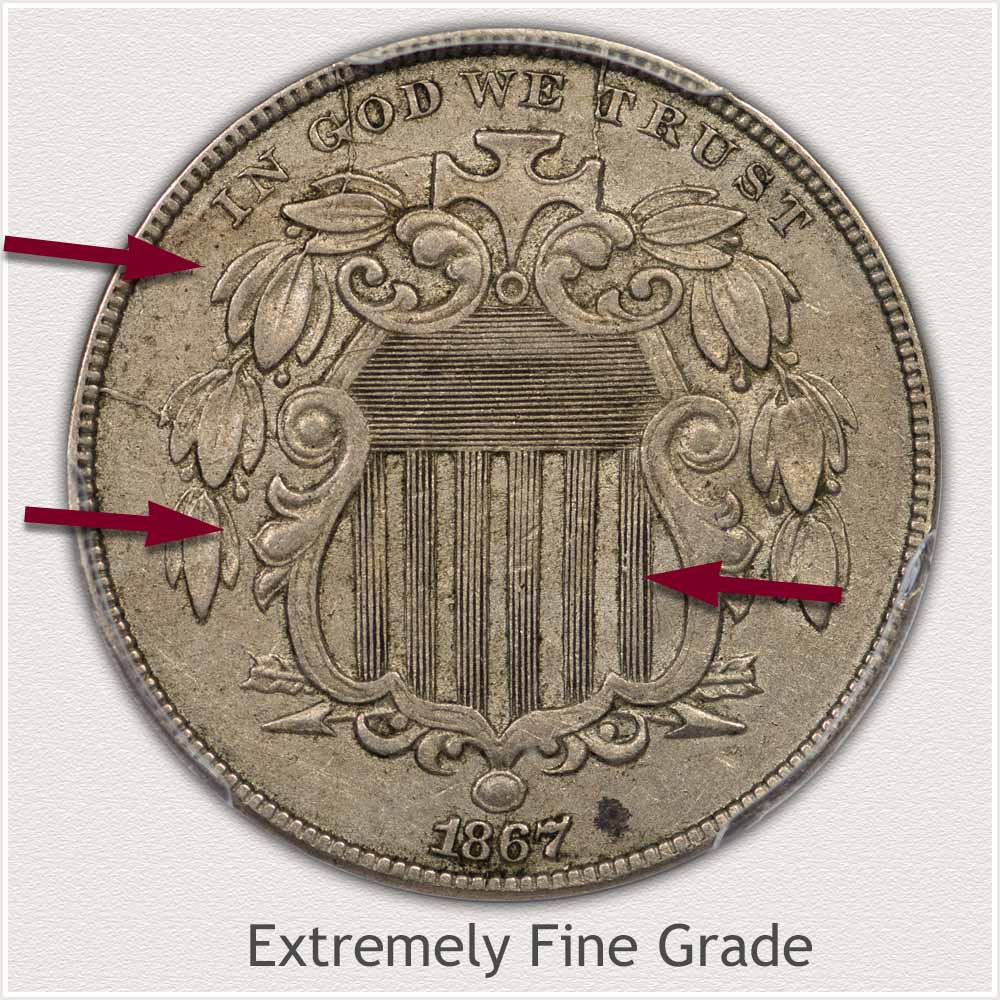
Extremely Fine: Use special care evaluating the condition of an 1871 Shield nickel. Few remain with well detailed design elements. At the Extremely Fine grade level, only slight traces of wear are visible. Key features measure specific amounts of wear. First, compare your coin with the image, it represents the grade. With a close match, continue with an evaluation of the shield's interior, outer border, and leaves on the sides.
A strict requirement at this grade level are well defined vertical lines. This center area must show sharp detail. To the side of these vertical lines, the frame provides a subtle, confirming detail. Examine the illustration, the frame border flattens where it meets the horizontal lines. Downward, smoothness on high contours of the frame is only at their tops. This border then curves to meet the lower ends of the vertical lines. Along the inner edge of the curve, a slightly faded raised line is just visible. Although merged in areas, a recess in the metal defines this fine line detail. Both sides of the frame show this subtle feature.
Leaves on the sides of the shield are well detailed when first minted. In Extremely Fine condition, high relief surfaces are slightly flattened due to wear. Examine towards the tips of the leaves, any flattened areas appear at the very ends. Additionally, the raised edges of the leaves show evidence of wear along just the upper ridge. On the left side of the example, leaf details are clearly visible.
A subtle point is now considered. Grading the leaves judges strike differences from the left to right sides of the design. Deep or light original impressions per side change the overall quality of the leaves. Stronger vein detail, more contour with the leaf centers, and height of the edges. Grading softly struck areas makes it difficult to gauge the true amount of wear. The example illustrates a stronger strike on the left when compared to the right side. To arrive at a grade, judge the best side of your coin.
Fine Grade
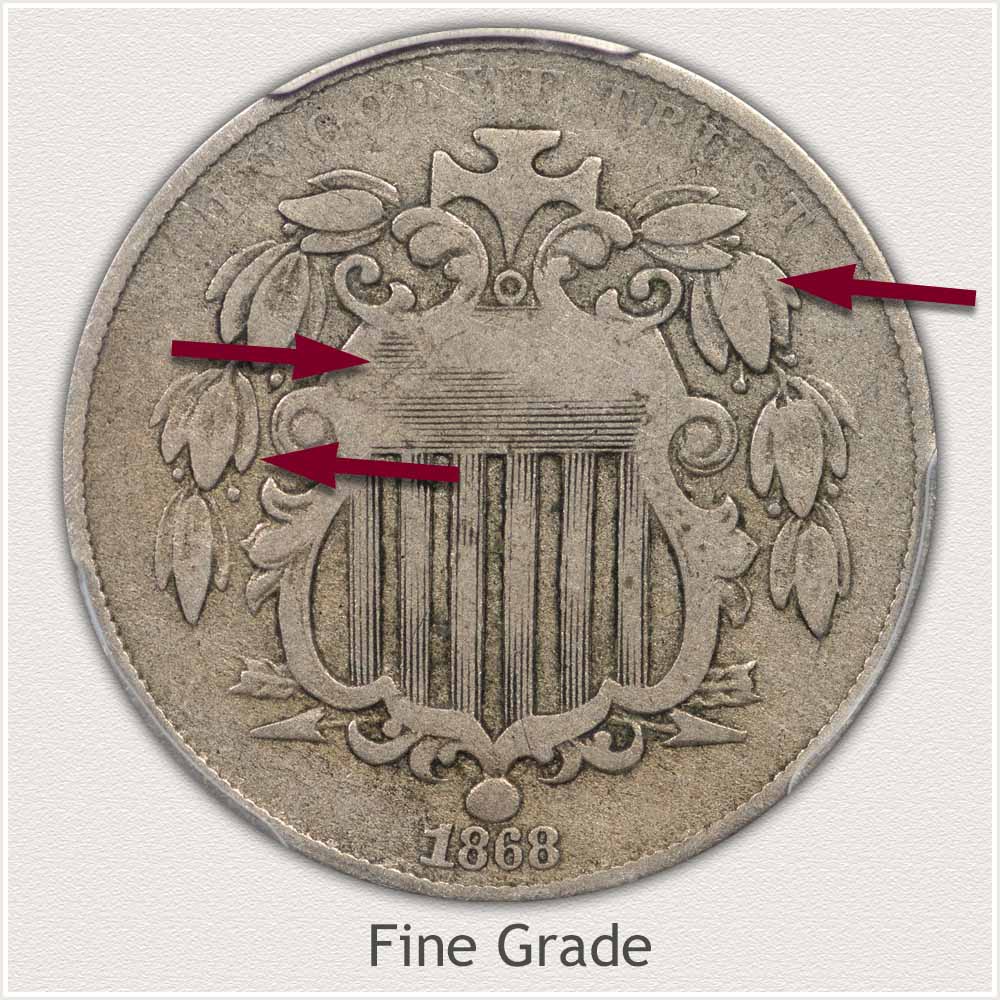
Fine Grade: A Shield nickel in Fine grade exhibits wear flattening only the highest contours. Additionally, there is some moderate merging of features. While low relief areas remain visible, it is only the high points missing small details. Two areas on the coin help measure the extent of wear. Particularly the leaves and horizontal lines within the shield provided grading metrics.
Inspect the edges of the leaves first. Most edges remain, separating the leaves. A few isolated areas of merging edges are typical of the leaf groups on either side of the cross. Strong leaf edges are a good measure of condition.
In addition to the leaf edges, judge the extent of wear on the leaves themselves. Inspecting the image, wear on most leaves extends only halfway into the leaf. This holds true except for the top most leaf group near the cross. Leaves completely smooth in these top groups identifies the amount of wear at this grade.
Judge the presence and clarity of the horizontal lines within the shield next. The grade standard is at least half of these lines remain visible. Weakness and merging of lines in the top area is balanced by sharp detail in the lower area. When examining the horizontal lines, focus on the remaining lines. Overall, half of the lines remain distinct.
Despite the presence of wear, Shield nickels in Fine condition are a pleasing coin. A clear date, clear major design features, and many fine details remain on a Fine grade nickel. This is a popular grade within the collector market.
Good Grade
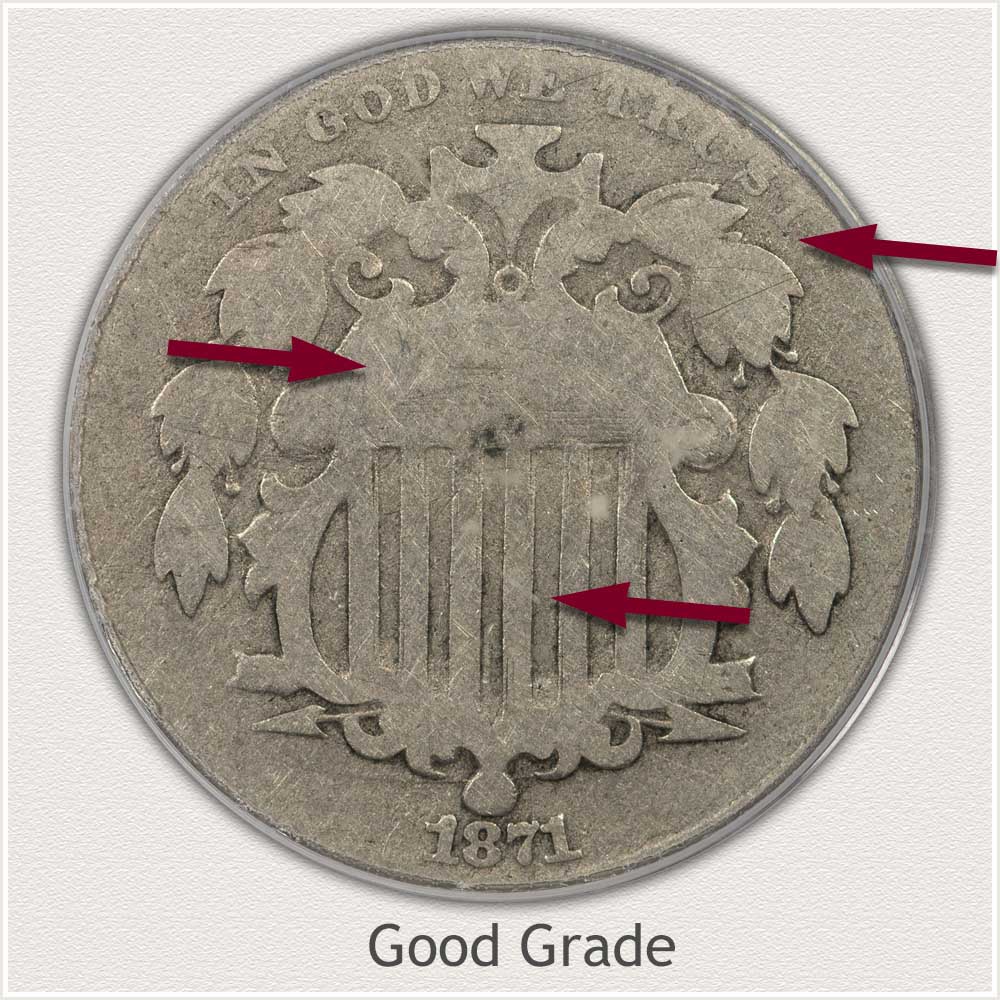
Good Grade: Of the relatively few 1871 nickels produced, even fewer remain. Of those available today, many are in heavily worn condition. This heavy wear condition defines the "Good" grade category.
The example image clearly shows the extent of wear within its center. This central area is a shield with a wreath of olive branches on either side. Distinctive, and required for the grade rating, are complete edges for all devices. The vertical shield stripes are full and defined. A complete outer edge of the frame remains bold. Although the inner leaf detail is smooth, the wreath shows a strong separation above the coin's field.
With the shield and wreath meeting grade standards, inspect for added quality. Clarity of the date and motto "In God We Trust" helps give the coin an appearance of boldness. A slight fading of the motto on the example coin is acceptable to meet the grade. A strong motto elevates eye appeal. This coin benefits from the bold date. On balance, a Good grade nickel is of collectible quality.
How to Video: Grading Shield Nickels
Step 3: | Special Qualities | Under One Million Minted
1871 a Scarce Year of all Nickles
An 1871 Shield nickel enjoys a high "desirability' factor in today's coin market. Of the sixteen dates struck for circulation, 1871 nickels are among the lowest produced. Under one million struck, specifically 561,000. It belongs to a special class of coinage.
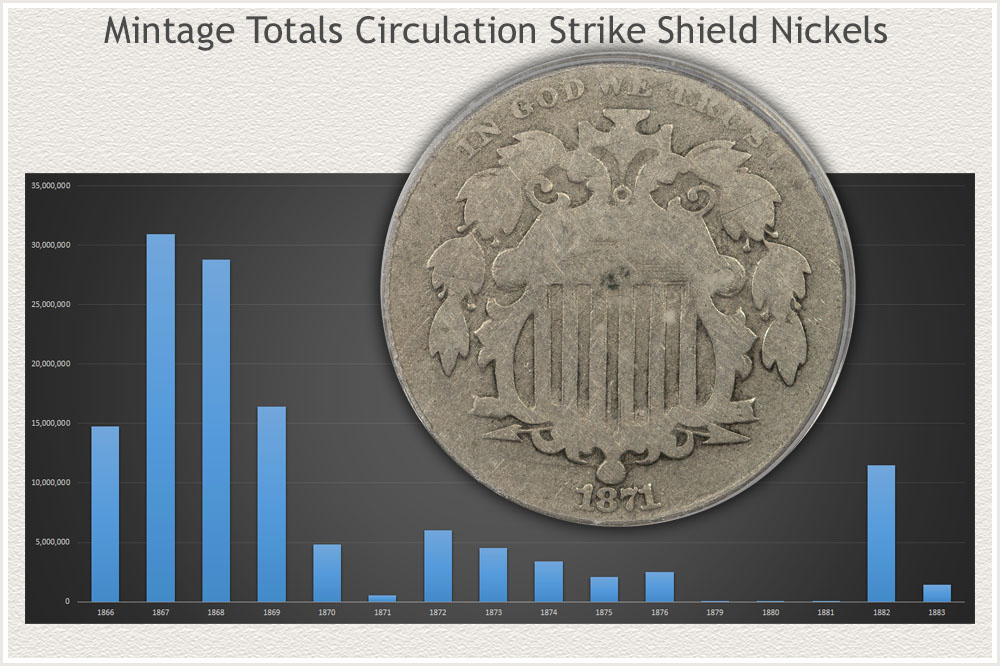 Low Mintage of 1871 Shield Nickels
Low Mintage of 1871 Shield Nickels
With three other dates posting mintages less than one million, 1879, 1880, and 1881. These nickels draw collector attention. In historical context, the next series, Liberty Nickels. All except the 1912-S, saw production above one million. Buffalo nickels, 1913 to 1938, followed the Liberty series. Only one year, the 1926-S Buffalo nickel fell below the important one million mintage mark. The Jefferson series, beginning in 1938, all record mintages well into the millions each year.
The 1871 nickel is one of only six in the entire five-cent nickel coinage with a mintage less than one million. As part of a collection of nickels, 1871 is a standout, historical year.
Another important trait finds the premiums at modest levels. Affordable costs allow many collectors to obtain an example, adding to their desirability. Although patience is required, nice coins enter the market at a steady pace.
1871 nickels are desirable additions to many forms of collections. A traditional date run collection includes the coin. Also, type collections of coins also add demand. These type sets seek one example of the different series. Adding an 1871 nickel to represent the Shield series increases its historical interest. These are coins with many special qualities, with strong market interest.
References
U.S. Mint. Catalogue of Coins of the United States
https://nnp.wustl.edu/library/book/554591
U.S. Mint. 1888 U.S. Mint Annual Report
https://nnp.wustl.edu/library/book/313
Coin Values | CoinStudy Articles
Date by Date
In Depth Shield Nickel Value
Shield Nickel Value | Complete Value Chart of All Years
Complete value chart listing of Shield Nickels. Note how much an 1871 is worth in high condition compared to other dates. The important step of judging condition is further illustrated with large grading images. This approach provides a step-by-step method to an accurate reading the chart.
How to Grade Shield Nickels | Visual Guide
Old Shield Nickels span a wide range of condition. Presented in the visual guide and video are key features examined, pointing to the various levels of wear. Close-up images highlight requirements to meet grading standards. Examine each coin using descriptions to accurately grade Shield Nickels.
Coin Grading Services | Premium Coins Benefit When Graded to Industry Standards
High value, $100 and above, coins enjoy market acceptance when professionally evaluated. The two leading coin grading services, authenticate, grade, and encapsulate the majority of the collectible coins in today's market. Review their services as part of evaluating any scarce coin.
Selling Coins | Organized and Planned
Use the proven methods followed by collectors when selling coins. Steps organize your coins, establish a grade range and value. Review the listing of auctions, coin conventions, and dealers. Find the best market to handle the collection.
Safe Coin Storage | Recommendations
Properly storing coins long term avoids unnecessary damage. Supplies designed specifically for the coin hobby protect coins and organize a collection. Today, modern, inert plastic holders house individual to many coins. A few basic supplies safely protect coins from damage and limit environmental exposure.
Coin values follow the popularity of a series. Large numbers of collectors create demand, resulting in premiums paid for coins. Insight into the popularity of a coin series highlights the strength of its value. Charts rank the interest of collectors by denomination and series.
★Coin Values Discovery finds 1871 Nickel Value and...
All old U.S. coin values. A full image and description index leads to value charts of U.S. coin series. Introduced is a step-by-step method to verify date and variety identification. How to judge condition is an important step covered within each series. As a significant feature of value, identify a coin's special qualities. Discover how much your box of old coins is worth.
